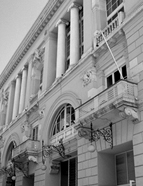

................................
As an institution devoted to the production and dissemination of scientific knowledge, the SGL amassed a documentary corpus (textual, iconographic, and material) crucial for historical studies, especially in its connections with Geography and Ethnology. This corpus remains to be explored in greater depth. Since its inception, the SGL called on its members to contribute documents, books, and objects of interest to enrich the archive and museum it was building. The role of corresponding members in constructing the overseas and scientific discourse was particularly noteworthy. Through their submission of news, memoirs, and information about colonies, their habitats, and the peoples they encountered, these members helped create an informational network that shaped metropolitan perceptions of overseas possessions. These contributors—explorers, traders, missionaries, judges, governors, and others—brought Africa, pragmatically and materially, into the metropolitan consciousness. The merger with the Central Permanent Commission on Geography (CCPG) represented the transfer of various responsibilities, notably the curation of collections (specimens, documents, and books on geography, history, ethnology, archaeology, and natural sciences). These collections significantly contributed to the advancement of knowledge about Portuguese territories, particularly the overseas provinces. Alongside its advisory, research, editorial, and colonial propaganda roles, this delegation of functions paved the way for the establishment of a museum. Beyond promoting colonial products commercially, the museum included collections of commercial and industrial, historical-commemorative, scientific, and artistic character. After negotiations with the state to acquire colonial collections displayed at the International and Colonial Exhibition in Amsterdam (1883), the SGL Ethnographic Museum opened to the public in 1884, showcasing an innovative industrial and commercial application of colonial artefacts. The integration of efforts and coordination with the Lisbon Colonial Museum, under CCPG’s supervision, was achieved with the 1892 merger of the two museums and their respective collections. The incorporation of collections into the SGL museum maintained a vibrant dynamic until 1940, fuelled by the organisation of national and international exhibitions (e.g., Antwerp, 1885), as well as individual and official contributions. Significant collections donated by Portuguese authorities represented reciprocation for the SGL’s support in hosting national (e.g., Porto, 1894; centennial of India, 1898) and international exhibitions (e.g., Antwerp, 1885; Paris, 1889, 1900, and 1927; London, 1921; Rio de Janeiro, 1922; Barcelona, 1929). This trend continued until the last major donation, formalised in 1940, originating from the Portuguese World Exhibition. However, the Ethnographic Museum faced challenges, including insufficient space, inadequate architectural and technical conditions for exhibitions, poor signage, overcrowding of objects, and a need for conservation and restoration. These issues led to a long period of devaluation of its collections until the 1970s. Rehabilitation efforts—inventorying, treating, reorganising, studying, and disseminating the museum's ethnographic collections—began during this period, initiated by art historian Marie-Louise Bastin, who worked on the Angolan ethnographic nucleus. From the 1990s, these efforts were furthered by the work of researcher Manuela Cantinho Pereira.
This work is financed by national funds through FCT - Foundation for Science and Technology, I.P, in the scope of the projects UIDB/04311/2020 and UIDP/04311/2020.
